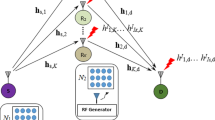Abstract
This paper presents a scheme for dual-hop amplify-and-forward multi-antenna, multi-relay selection over Nakagami-m fading channels. A source-selected best relay performs maximal ratio combining on received data, applies variable gain, and then uses beamforming to transmit to a destination device. Such a configuration is beneficial for end-to-end communication using single antenna mobile terminals with a multi-antenna relay infrastructure. Closed form expressions for performance metrics are derived that cater for arbitrary number of relays, arbitrary number of receive and transmit antennas and different fading parameters. Results are verified through simulation. Furthermore, the influence of multiple antennas, the effects of fading, power imbalance between hops, and the beneficial impact of additional relays are explored.






Similar content being viewed by others
Notes
\(f(x) =o(h(x)) \ \text{ as} \ x\rightarrow 0 \ \displaystyle \lim _{x\rightarrow \ 0}{(f(x)}/{h(x))}=0 \)
References
Adinoyi, A., & Yanikomeroglu, H. (2007). Cooperative relaying in multi-antenna fixed relay networks. IEEE Transactions on Wireless Communications, 6(2), 533–544.
Amarasuriya, G., Tellambura, C., & Ardakani, M. (2012). Joint relay and antenna selection for dual-hop amplify-and-forward mimo relay networks. IEEE Transactions on Wireless Communications, 11(2), 493–499.
Asghari, V., Maaref, A., & Aissa, S. (2010) Symbol error probability analysis for multihop relaying over Nakagami fading channels. In Proceedings of IEEE Wireless Communications and Networking Conference (WCNC), pp. 1–6, April 2010.
Chen, S., Wang, W., Zhang, X., & Sun, Z. (2010). Performance analysis of OSTBC transmission in amplify-and-forward cooperative relay networks. IEEE Transactions on Vehicular Technology, 59(1), 105–113.
Conne, C., Ju, Min Chul, Yi, Zhihang, Song, Hyoung-Kyu, & Kim, Il-Min. (2010). SER analysis and PDF derivation for multi-hop amplify-and-forward relay systems. IEEE Transactions on Communications, 58(8), 2413–2424.
da Costa, D. B., & Aissa, S. (2009). Cooperative dual-hop relaying systems with beamforming over Nakagami-m fading channels. IEEE Transactions on Wireless Communications, 8(8), 3950–3954.
Gradshteyn, I. S., & Ryzhik, I. M. (2000). Table of integrals, series, and products (6th ed.). New York: Academic.
Hasna, M. O., & Alouini, M.-S. (2004). A performance study of dual-hop transmissions with fixed gain relays. IEEE Transactions on Wireless Communications, 3(6), 1963–1968.
Kim, Jung-Bin, & Kim, Dongwoo. (2009). Comparison of tightly power-constrained performances for opportunistic amplify-and-forward relaying with partial or full channel information. IEEE Communications Letters, 13(2), 100–102.
Krikidis, I., Thompson, J., McLaughlin, S., & Goertz, N. (2008). Amplify-and-forward with partial relay selection. IEEE Communcations Letters, 12(4), 235–237.
Louie, R.H.Y., Li, Y., & Vucetic, B. (2008). Performance analysis of beamforming in two hop amplify and forward relay networks. In Proceedings of IEEE International Conference Communications (ICC), pp. 4311–4315, May 2008.
Pabst, R., Walke, B. H., Schultz, D. C., Herhold, P., Yanikomeroglu, H., Mukherjee, S., et al. (2004). Relay-based deployment concepts for wireless and mobile broadband radio. IEEE Communications Magazine, 42(9), 80–89.
Prakash, S. (2011). Selection diversity techniques in MIMO and cooperative relaying. PhD thesis, Nanyang Technological University, Singapore, 2011.
Prakash, S., & McLoughlin, I. V. (2011). Performance of dual-hop multi-antenna systems with fixed gain amplify-and-forward relay selection. IEEE Transactions on Wireless Communications, 10(6), 1709–1714.
Yilmaz, A., & Kucur, O. (2010). Error performance of joint transmit and receive antenna selection in two hop amplify-and-forward relay system over nakagami-m fading channels. In Personal indoor and mobile radio communications (PIMRC), 2010 IEEE 21st international symposium on, pp. 2198–2203. IEEE, 2010.
Yuksel, M., & Erkip, E. (2007). Multiple-antenna cooperative wireless systems: A diversity;multiplexing tradeoff perspective. IEEE Transactions on Information Theory, 53(10), 3371–3393.
Zhao, Yi, Adve, R., & Lim, Teng Joon. (2006). Symbol error rate of selection amplify-and-forward relay systems. IEEE Communications Letters, 10(11), 757–759.
Author information
Authors and Affiliations
Corresponding author
Rights and permissions
About this article
Cite this article
McLoughlin, I.V., Prakash, S. Mobile Communications Using Source-Selected Multi-Antenna AF Relays Over Dual-Hop Nakagami-\({\varvec{m}}\) Channels. Wireless Pers Commun 71, 3045–3057 (2013). https://doi.org/10.1007/s11277-012-0989-4
Published:
Issue Date:
DOI: https://doi.org/10.1007/s11277-012-0989-4




